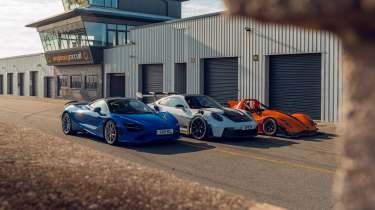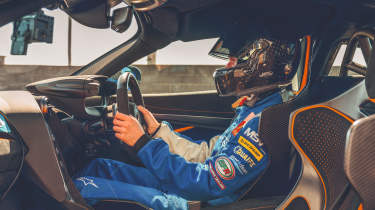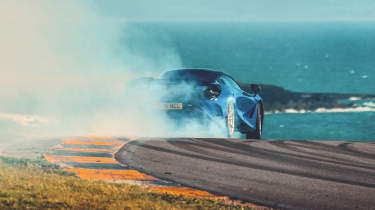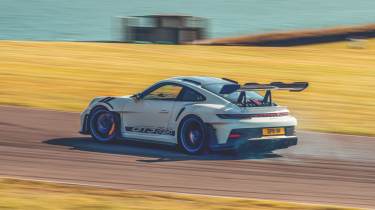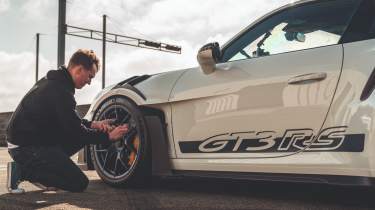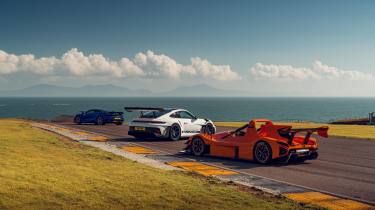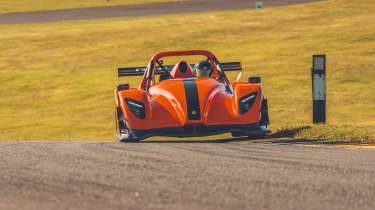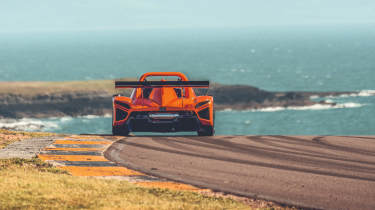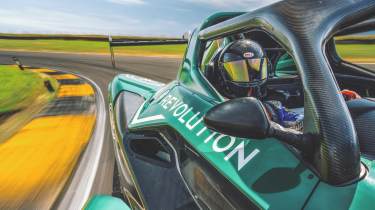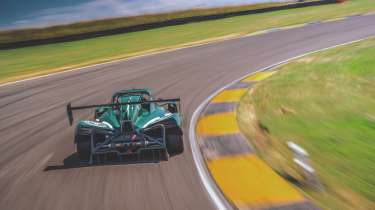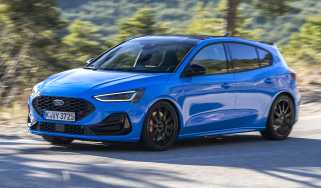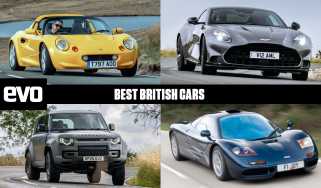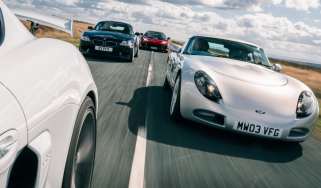McLaren 750S and Porsche 911 GT3 RS v hardcore track weapons – can the road racers compete?
We compare the merits of four very different track cars, the McLaren 750S, Porsche 911 GT3 RS, Radical SR3 and Revolution R500 Evo
Place your bets, please. Which of these do you reckon will be quickest around a circuit? The McLaren 750S, a 740bhp, carbon-tubbed mid-engined supercar; the Porsche 911 GT3 RS 992, a 911 with active aero and damper and diff settings you can tweak mid-lap; or a Radical SR3 XXR, a dedicated track car with a fraction of the power but also a fraction of the weight? We’re as intrigued as you to find the answer.
It’s been a while since we’ve been to Anglesey Circuit for an update to evo’s lap time leaderboard but we’re making up for lost time by bringing some remarkable metal (and carbonfibre) to put against the stopwatch. The McLaren 750S is an even more potent evolution of the 720S, which set a searing lap time of 1:11.05 in 2018. We already know the 750 is superb on track from its launch at Estoril, and that it’s thrilling on the road from evo Car of the Year 2023 (where it finished an honourable third). Porsche’s 992-generation 911 GT3 RS, meanwhile, has the accolade of being both reigning eCoty champion and our Track Car of the Year, having proven spellbinding around Cadwell Park in the spring (evo 322) following its performance in the Scottish Borders at the end of 2023. With active front and rear wings, it’s not only the most track-focused GT3 RS to date, but also one of the most track-focused road cars you can buy.
Radical’s flyweight SR3 XXR has just been updated for the 2025 model year. It has a third of the power of the McLaren and half that of the Porsche but it’s also half their weight and, as it’s a dedicated track car, runs on slick tyres. We also have a further track car joker to play: the mighty Revolution 500 Evo, which set by far the quickest lap time at Cadwell during TCoty. We’re curious to see what kind of pace it can produce here at Anglesey – and where these four machines will slot into evo’s overall leaderboard.
You can follow the link above for the full updated Leaderboard. The reigning benchmark time belongs to the BAC Mono R, which recorded a 1:06.9 lap (on slick tyres), ahead of its Mono 2.5 sibling at 1:07.7 (on road-legal rubber), McLaren’s track-only P1 GTR at 1:08.7 and Ferrari's SF90 Assetto Fiorano, at 1:10.0. As with all evo lap times at Anglesey, we’re using the Coastal circuit layout, which includes the tight, tricky, downhill Corkscrew section, and today’s times will be set by editor-at-large Dickie Meaden and myself.
Nobody does purity of purpose in a supercar quite like McLaren. With zero switches on the wheel and a clear view through the bowl-like windscreen ahead, the 750S’s cabin is an oddly calming environment. Although the knowledge that there’s a 740bhp engine bolted to the back of the cockpit is enough to raise your heartbeat a notch or three.
In its evolution from 720S to 750S, it’s lost weight (around 30kg), gained power (from 720 PS/710bhp to 750 PS/740bhp, hence the name) and undergone a few set-up and aero tweaks, among other updates. There’s also more torque and a shorter final drive, as per the McLaren 765LT, for even greater in-gear urge. They must be made of strong stuff in Woking because I’m not sure anyone outside of McLaren has ever climbed out of a 720S and thought, ‘If only it had a bit more poke…’
When evo timed the 720S here in near-perfect conditions in 2018, it recorded a time only three tenths slower than the 903bhp McLaren P1 hypercar. Today the conditions aren’t totally optimum: a colder day and a green-ish track. But, in exploratory warm-up laps on scrubbed Pirelli Trofeo R tyres (an option available to customers), the 750S already feels superb. Feedback flows to you constantly, through the steering – always a McLaren plus-point, now with a new rack for the 750S with a slightly weightier feel and quicker too, in line with some subtle geometry changes – and through the chassis too. The ultra-rigid carbon structure helps with consistency corner to corner, and it’s a transparent car to read.
This car is in a relatively track-focused spec, with uprated brakes and carbon seats, both shared with the McLaren Senna. The latter are clearly designed for broader drivers than me; I slide side-to-side within them and need to pull the optional multi-point harness tight to hold me in place. Both Handling and Powertrain driving modes are set to Track, for the stiffest suspension and most aggressive engine map. It goes without saying that the 750S is obscenely fast. Give it everything and the way it surges forward is eye-wideningly intense.
It’s still driveable and intuitive, however, perhaps more so than something with about as much power as a ’90s F1 car behind your shoulder blades has a right to be. McLaren’s Variable Drift Control (VDC) system offers a sliding scale (no pun intended) for how much support or otherwise you’d like from the stability and traction control systems. It can quell slides completely or help you sustain them, a bit like riding a bike with stabilisers.
The 750 feels less understeer-biased than its 720 processor, with three per cent softer springs at the front and four per cent firmer at the rear, but it’s still more likely to push its nose than let go at the rear – the better for confidence and stability. If you do start to build a little more understeer than you want, you can ease off the throttle and it swiftly stabilises and finds its line again. If you’re more aggressive, you can carry speed into a corner, come off the throttle and let the car rotate into oversteer. From here you can let it neutralise, or feed the power in to hold the McLaren in a slide. It’s as balanced as it is thrilling, even with the stability control switched off entirely.
Or, at least, it is while driving at seven to eight tenths during sighting laps. Pushing harder for the timed laps (on a new set of Trofeo Rs), both Dickie and I find the 750S a spikier car to handle. It’s more stable under braking than its predecessor but it can be an edgy car on corner-exit, where wheelspin is tricky to contain. Anglesey is a track of two halves: you can really attack the first half, with fast, open corners and heavy braking zones. The second half is all about patience and precision, and it’s easy to overdrive the car; any car, but particularly the 750S. If you’re not precise and prudent with your right foot, it’s easy to either trigger the traction control, or, if it’s switched off, wheelspin the power away. Perhaps it’s in these situations that the 750S’s lack of an electronically controlled diff, unlike that fitted to the McLaren Artura, finally begins to show.
Initially I keep the VDC switched on, in its most lenient mode, assuming it’ll give me a little bit of traction control to lean on like a racing car. The system ultimately slows you down, however. It’s best if you swallow a brave pill and switch everything off, and that’s the setting in which we record the fastest times. You need fast reflexes as well as a patient right foot to get the best from the McLaren, and both of us find ourselves catching slides and managing oversteer in places.
Perhaps it’s a function of both the new, shorter gearing and the higher boost pressure (together with lighter pistons from the 765LT and a higher-flow fuel pump): you get into the boost sweet-spot just as the wheels start to overspeed and the resultant wheelspin can be tricky to contain. ‘It’s exciting, in the way that juggling with chainsaws is exciting,’ says Dickie. Even when it’s sliding, however, it’s controllable and you always know where you are with it. The trouble is that it’s easy to overheat its tyres, after which they never quite fully recover, giving a narrow window of laps in which to set a time.
On the road you’re well below these limits, and if it were your own car on a trackday, without the pressure of the stopwatch running and the 720S’s lap time a proverbial carrot dangling in front of that domed windscreen, you likely wouldn’t encounter the 750’s spikier side. It really is a definitive 21st century supercar: truly thrilling, brilliantly exploitable. Just a little more ragged than we expected beyond eight or nine tenths.
On which: its best time of 1:11.74 is two tenths slower than the 720S recorded. Track conditions may well have played a big part in this – the day before our test Anglesey’s surface had been washed clean by a spectacular storm – although we also wonder if its lower gearing may ultimately have made the 750S a bit less driveable (and too easily over-driveable) on corner exit. ‘All the things that are great about McLarens are there,’ Dickie says. ‘The way you interact with the modes, the driving position, the whole way the car functions. This circuit may not play to its best strengths and it would probably be a different thing at a more flowing track. I don’t doubt that if you’re dialled in to the car, you’d unlock more lap time. But perhaps the unpalatable truth is that only a professional driver may be able to make the difference in lap time between 720S and 750S.’
The Porsche, by contrast, is a more serene experience. As its bewinged body suggests, it’s suckered-down stable in the fast corners – where you really can feel the downforce at work – and superbly tractable in the slower stuff. The GT3 RS honestly feels like a racing car, in the instant yet measured way it responds to any driver input and with so much stability under braking, allowing you to hit the pedal as hard as you like. Where the McLaren is dancing a little through the fast corners, the Porsche’s downforce gives you rock-solid balance to lean on. It’s a remarkably consistent car to drive. Every lap, every corner, it responds in the same way; it never does anything untoward.
Despite wings squashing it into the track surface, the RS is remarkably light on its feet and doesn’t use up its tyres (road-legal but track-orientated Michelin Cup 2 Rs) at the same rate as most other road cars on track. Where the McLaren’s tyres had given their best in their first few laps and dropped off in performance thereafter, the 911 still turns in similar times after sustained hard laps. Unless deliberately provoked, the rear is so stable that the GT3 RS is limited more by front grip than rear, but its solid stance enables you to commit to corners with more confidence than in the 750S.
Perhaps the thing that most puts the McLaren’s sheer firepower into context is that the Porsche feels slow in a straight line by comparison. With 343lb ft to the McLaren’s 590lb ft, it feels a bit flat. But the beauty of that lower torque figure, and its crisp naturally aspirated throttle response, is that you can lean on the throttle earlier and harder than in the 750S without fear of accidentally bonfiring the rear tyres. Even with everything switched off, the GT3 RS has the kind of caterpillar-track traction 911s are famed for.
And even if the 4-litre flat-six isn’t capable of the same sledgehammer performance as the McLaren’s 4-litre twin-turbo V8, it’s still such an exciting engine to conduct. ‘I love the powertrain; it’s always special hearing that 9000rpm red line and feeling those gearchanges,’ Dickie says. ‘It’s such a satisfying thing to drive.’ Like the McLaren, the Porsche has a dual-clutch, paddleshift transmission; this being an RS and therefore a more track-focused car than the regular GT3, it’s available with a PDK only, but there’s still drama in the way upshifts ping into place and the automated rev-match yelp of the flat-six on downshifts.
Whereas manufacturers normally send some level of support when we record times at Anglesey, whether that be spare tyres or experts to advise on how to get the best from the car, Porsche left us to it with the RS. The other cars arrived at Anglesey by truck or trailer, accompanied by engineers, but we drove the 911 on the road for the 400-mile round trip. That shows a commendable amount of faith by Porsche in its product. And a prudent approach to tyre budgeting.
That said, the 992-gen RS is one car that might benefit from an advisor on hand because of its sheer range of configurability. The steering wheel is packed with little satellite rotary controllers via which you can adjust the locking rate of the electronically controlled differential (on coast and under power), damper settings front and rear (independently for compression and rebound), and multiple levels of traction and stability control.
You could lose an entire day looking for your optimum combination, so for this exercise we started with a baseline set-up similar to the one we used at Cadwell Park and worked from there, selecting a slightly more aggressive power setting for the diff to help the car out of Anglesey’s slower corners and keep stability for its faster ones, but not too much, to help it change direction well through the twiddly second half of the lap.
We left the wings in their dynamic mode, flattening in an auto DRS function for straight-line speed and standing upright in an auto air-brake function; the two front wings (hidden inside the nose) and massive rear wing work in tandem to balance aero load front and rear.
The circuit is dry and warm, but not that warm, and a little slippery in places, so we set the dampers a little firmer than baseline but not to their firmest setting. (Between softest and firmest settings there’s 20 per cent difference, Porsche’s engineers having ensured the car doesn’t become dramatically imbalanced if you set the dials to extreme contrasts.)
The RS records a best time of 1:11.98 (rounded up to 1:12.0 for the leaderboard). Its driveability and consistency get it within a couple of tenths of the McLaren, despite having 30 per cent less power. Just as the McLaren was slightly slower than the 720S, the 992 GT3 RS’s time is around eight tenths slower than the previous-gen 991.2 GT3 RS.
As with the McLaren, track conditions may have played a part, and with more time to explore and exploit the 911’s configurable modes, we believe it’s capable of more. Certainly there is time to be had adjusting the diff settings between Anglesey’s contrasting first and latter sectors. The RS was, however, eight tenths faster than the regular, non-RS 992.1 GT3, also in PDK form. And regardless of lap time, it’s blown us away in how rewarding it’s been to drive.
‘It’s a perfectly conceived car,’ Dickie says: ‘Fast but not too fast, and it doesn’t prescribe a certain way of driving; you can drive it how you want to, and get what you want from it. Even if it was a session where you didn’t get the most from the car, you’d still get the most out of yourself. I’m sure you could take it to the Nürburgring on a grotty day and feel quite safe and enjoy it. I’d probably park the McLaren until the track dried…’
Given what it’s capable of on track, it’s hard to believe the 992 RS is so enjoyable and capable on the road, too. Perhaps demonstrating the 911’s bandwidth, Radio Wales traffic news started playing through the speakers during the cool-down lap to the pits. And I’ll listen to a podcast on the way home. It’s a remarkable car.
The Radical is not a road car. It’s a car designed purely for the track – both for racing, in Radical’s own championships and within other formulae around the world, and for pure recreational fun on trackdays. SR3 customers are split roughly 50:50 between the two camps.
Is it a bit unfair to pit a pure track car against road-legal cars? That depends on your view of such track-only machines, but if manufacturers are claiming to build the fastest cars for the road and track, they need to be able to take on the specialists that occupy the latter segment as much as they do the bigger brands in the former.
The XXR evolution of the evergreen SR3 (originally launched back in 2002 and developed continuously since) made its debut in 2022. Over its SR3 XX predecessor, it gained solid-state data tech and the latest-gen engine from Radical’s RPE power unit division. The SR3 is available with either a 1340cc engine or a 1500cc variant, as per this car. For the 2025 model year, it’s gained a new carbon seat with wraparound headrest and a new harness design, a new front splitter and redesigned sidepods shifting the aero balance a little toward the front at high speeds, a redesigned steering rack to reduce driver fatigue in long races, and a greater range of custom colours for wheels, harness and body – including this car’s visually arresting Tangerine.
If the McLaren has a slightly reclined driving position, the lay-down Radical is the full dentist’s chair. Arguably with a similar level of intimidation. But once you get moving, the SR3 feels so immediate and so pure that any nerves quickly transform into exhilaration. It’s almost closer to a kart than a car. You use a conventional clutch pedal to pull away, but once you’re moving you can forget about your left foot and use the gearchange paddles – or use your left foot to brake if you prefer; the pedals can be set up to cater for right- or left-foot brakers. And the braking performance is frankly mind-blowing after the two road cars.
With so much less weight to carry, and the extra grip of the slick tyres once they’re warmed through, you can stay flat – change up a gear, even – in places where you’re already braking in the Porsche and McLaren. The SR3 is unerringly stable. There’s no ABS, but you have to be hitting the pedal very hard to lock a tyre.
It’s in these braking areas that the Radical makes big gains over the other cars here – but it can carry enormous corner speed too. ‘There is something quite magical about the way the Radical turns in,’ Dickie says. ‘If you’re inclined to try and drive a car as fast as you can, it’s a car with a level of cornering ability that takes you to a different place.’ And with only 139lb ft from its bike-based engine compared with the 911’s 343lb ft, the McLaren’s 590lb ft and the 410lb ft of the Revolution you can get to full throttle in the Radical almost immediately, with little worry of wheelspin. If you get oversteer, it’s more likely to be through momentum than under power. You’re working in a narrower window than with the other cars here.
A narrower powerband, too. The 241bhp engine’s Suzuki motorcycle roots mean you need to keep the revs far higher than in the other cars to be in the engine’s sweet-spot. I love the way it shrieks; the way the high-revs, low-torque combination demands you corner without scrubbing off speed and spend minimal time on the brakes and maximum time on the throttle.
The lap time: 1:06.44, the fastest yet recorded on the evo leaderboard and multiple seconds quicker than the McLaren and Porsche. It’s a reminder that even the most epic of road cars have their work cut out against a purpose-built track car.
And the ultimate dual-role trackday/race car that evo has tested in the last 12 months is the Revolution 500 Evo. Carbonfibre monocoque chassis, downforce to shade even the GT3 RS (800kg of it at 130mph), and a supercharged 3.5-litre V6 with 500bhp at the wheels (and a power-to-weight ratio of 608bhp per ton). It’s a very serious machine.
Like the Radical, it’s aimed at both racing and trackday customers, though it isn’t a direct competitor as such: faster and pricier, it’s intended for drivers looking to make the step towards Le Mans-style prototypes, or who are after a faster but more affordable alternative to high-end GT racing. But, as with the Radical, around half of Revolution’s customers globally are pure trackday enthusiasts. Despite its deadly-serious appearance, it’s been designed to be as fun to drive as it is fast.
It certainly sounds serious, though, as Revolution’s Nigel Redwood warms the 500 Evo up before our laps. The V6’s gritty growl is overlaid by high-pitched tones from the supercharger’s bypass valve, which Revolution uses to help manage the torque delivery in conjunction with the traction control system. The TC is a sophisticated racing system, with two different dials on the steering wheel for gain and slip. That means you can really lean on the throttle hard out of Anglesey’s slower corners, despite the monstrous torque-to-weight ratio. You still need to be on your toes, however; it’s there to help you transmit the torque to the tarmac effectively rather than save you from a spin like a road car system.
There are myriad other controls on the F1-style steering wheel too, including different levels of power steering assistance and different engine maps (we’re using the full-on qualifying mode). All of this adds up to make the Revolution the most intimidating car here psychologically. As Dickie puts it, ‘You need to put on your big boy pants.’ But once you’ve had a lap or two to adapt, you’re having too much fun to be frightened. As well as being devastatingly fast, the 500 Evo is also an entertainer. There’s big grip of course, but it’s anything but an on-rails racing machine. You’re correcting slides, working with the car, making a difference. You’re totally engaged.
Anglesey’s Coastal circuit doesn’t totally suit the Revolution: it’s a bit too big and bulky for the Corkscrew section and would be better suited to the longer International layout. ‘It would be awesome to take it to Spa or Silverstone,’ Dickie muses. ‘Somewhere with long fast curves.’
And yet it’s faster even than the smaller, lighter (but significantly less powerful) Radical: its quickest lap is 1:05.33, more than a full second faster than the SR3, and it smashes the BAC’s 1:06.9 record. The Mono R does retain the moral high ground and honour of being the fastest road-legal car on the leaderboard: you can’t fit a numberplate to the Revolution or Radical and drive them home. That said, the Mono R did set its best lap on track-only slick tyres (as did the McLaren P1 GTR); the quickest car on road-legal tyres remains the Mono 2.5. This is one battle that is unlikely to end anytime soon.
| McLaren 750S | Porsche 911 GT3 RS (992) | Radical SR3 XXR | Revolution R500 Evo | |
|---|---|---|---|---|
| Engine | V8, 3994cc, twin-turbo | Flat-six, 3996cc | In-line 4-cyl, 1500cc | V6, 3498cc, supercharged |
| Power | 740bhp @ 7500rpm | 518bhp @ 8500rpm | 241bhp @ 10,000rpm | 500bhp @ 7700rpm |
| Torque | 590lb ft @ 6500rpm | 343lb ft @ 6300rpm | 139lb ft @ 7000rpm | 410lb ft @ 5000-7000rpm |
| Weight | 1389kg (1426kg as tested) | 1450kg (1489kg as tested) | 620kg (699kg as tested) | 835kg (dry; 981kg as tested) |
| Power-to-weight | 541bhp/ton | 363bhp/ton | 380bhp/ton | 608bhp/ton (dry) |
| Tyres as tested | Pirelli P Zero Trofeo R | Michelin Pilot Sport Cup 2 R | Hankook Ventus slicks | Goodyear slicks |
| 0-62mph | 2.8sec | 3.2sec | 3.1sec | c2.5sec |
| Top speed | 206mph | 184mph | 147mph | 185mph |
| Basic price | £244,760 | £192,600 | £108,000 | £228,000 |

